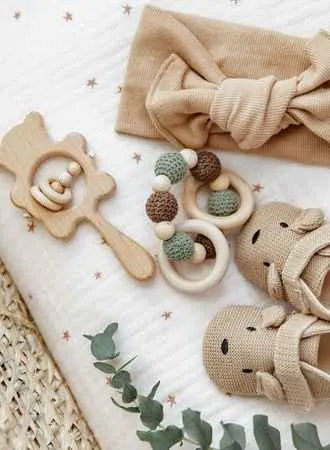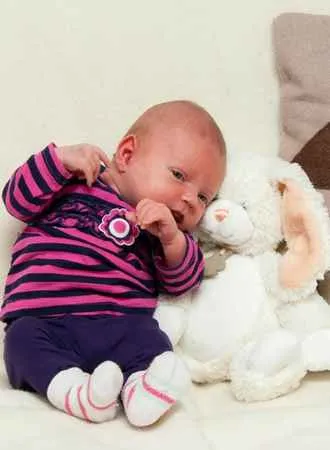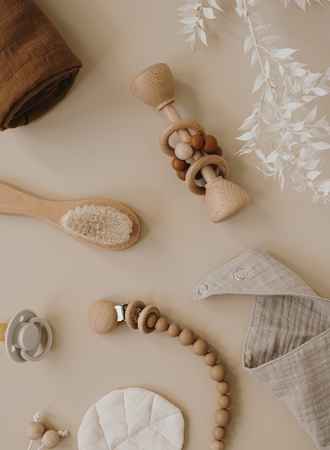Stepping into the world of parenthood and pondering when to introduce toys to your newborn?
It’s a common question many new parents grapple with. While newborns primarily engage with the world through feeding, sleeping, and observing, introducing appropriate toys can be beneficial even in these early stages.
Drawing from my expertise in child development and toys, I’ve crafted a comprehensive guide to help you understand the optimal timeline and rationale for introducing toys to newborns.
Let’s embark on this nurturing journey together, understanding the sensory and developmental needs of newborns, and discovering how early toys can foster growth, bonding, and stimulation during these formative weeks.
When introducing toys to newborns, it is recommended to wait until they are at least three months old. At this age, babies can begin to grip objects and use their hands more effectively while playing. It is also beneficial for parents to look for toys that have multiple sensory experiences like rattles, textures and colors as these will help with their development of fine motor skills.
Key Takeaways on When Babies Start Playing
- Wait until babies are at least three months old to introduce toys that promote fine motor skills.
- Introducing toys to newborns improves memory, hand-eye coordination, and problem-solving abilities.
- When introducing toys to newborns, consider safety factors and enhance their experience by choosing appropriate toys, introducing one toy at a time, limiting screen time, encouraging exploration, and showing enthusiasm.
When to Introduce Toys to Newborns
Introducing toys to newborns can be a beneficial way to stimulate their senses and promote early developmental milestones. However, the timing and type of toys matter, given a newborn’s limited abilities and sensitivities.
| Age | Toy Recommendations | Purpose & Benefits |
|---|---|---|
| 0-1 Month | – Soft, high-contrast visuals (black, white, and red patterns) – Gentle sound machines or soft music | – Newborns can see only about 8-12 inches in front of them. High-contrast visuals cater to their developing vision. – Soft sounds can soothe and calm, mimicking the womb’s environment. |
| 1-2 Months | – Hanging mobiles with high-contrast patterns – Soft rattles with gentle sounds | – Encourages visual tracking as eyesight improves. – Introduces auditory experiences and can capture attention. |
| 2-3 Months | – Baby-safe mirrors – Soft, textured toys | – Babies begin to recognize their reflection, fostering self-awareness. – Tactile stimulation promotes sensory development. |
| 3-4 Months | – Soft cloth books with high-contrast patterns and textures – Wrist rattles or booties | – Introduces the concept of books and encourages visual and tactile exploration. – Enhances awareness of limbs and encourages movement. |
Some key points to remember:
- Safety First: Always ensure that toys are age-appropriate, free from small parts or choking hazards, and made of non-toxic materials. Toys should be checked regularly for wear and tear.
- Supervision: At this young age, always supervise any play or interaction with toys – hanging toys are great for newborn babies.
- Sensory Overload: Avoid overwhelming the baby with too many toys or stimuli at once. It’s better to introduce one toy at a time and observe how the baby reacts.
- Interaction: While toys can be beneficial, nothing replaces human interaction. Singing, talking, and cuddling are vital forms of stimulation and bonding.
- Every Baby is Different: While the table provides a general guideline, remember that every baby is unique. Some might show interest in certain toys earlier or later than typical.
Lastly, while toys can provide stimulation and entertainment, they are just one tool in a broader toolkit that includes human interaction, exploration of the environment, and daily routines.
Can Newborns Play with Toys?
Certainly! Newborns have limited vision, motor skills, and cognitive abilities, but they can still benefit from certain types of toys that cater to their developmental stage.
| Type of Toy | Description | Benefits for Newborns |
|---|---|---|
| High-Contrast Toys | Toys featuring bold, black and white or high-contrast patterns. | Stimulates visual development as newborns can best see high-contrast colors. |
| Soft Rattles | Gentle rattles made of soft materials with a mild sound. | Introduces auditory experiences and sensory toys and can grab attention. |
| Hanging Mobiles | Mobiles with high-contrast patterns or soft, moving parts to hang above the crib. | Encourages visual tracking and focus for baby play. |
| Mirrors | Baby-safe mirrors that can be placed in the crib or play area. | Babies are often fascinated by their reflection, promoting visual focus and self-recognition. |
| Soft Cloth Books | Fabric books with high-contrast patterns, textures, and simple images. | Introduces early concepts of books, textures, and visual patterns. |
| Soft Music or Sound Machines | Devices that play gentle lullabies or soothing sounds like heartbeat or white noise. | Can soothe and comfort a newborn, aiding in sleep. |
| Soft, Textured Toys | Toys made of varied materials like plush, crinkle fabric, or ribbons – stuffed toys. | Stimulates tactile exploration and sensory development for babies play. |
| Wrist Rattles or Booties | Soft rattles that can be attached to a baby’s wrists or feet. | Encourages movement and makes babies aware of their limbs. |
It’s essential to remember that newborns don’t actively “play” with toys in the way older infants or toddlers do. Instead, these early toys are more about providing sensory experiences and stimulating development.
Safety is paramount, so always ensure toys are age-appropriate, free from small parts or choking hazards, and checked regularly for wear and tear. Additionally, supervised playtime and interaction are crucial at this age.

When Do Babies Start Playing With Toys?
Babies start showing interest in toys and objects around them from a very young age, but the way they play and interact with these items evolves as they grow and develop. Here’s a general timeline of when and how babies typically start playing with toys:
- 0-3 months:
- Focus on Faces: Newborns are especially drawn to human faces. They might not play with toys per se, but they’re very attentive to caregivers’ faces.
- Grasping Reflex: Babies have a natural reflex to grasp objects, though they don’t have purposeful control over their hand movements yet.
- High-Contrast Toys: Babies in this age range can see high-contrast patterns best, so black and white or brightly colored toys might catch their attention. Soft rattles or toys that play music might also be of interest.
- 3-6 months:
- Hand Control: Babies begin to develop better hand control and can hold toys and bring them to their mouths for exploration.
- Interest in Rattles: The sound and feel of a rattle can be fascinating for a baby in this age range.
- Tummy Time Play: During tummy time, babies might start reaching for and batting at toys placed in front of them – baby gym is good for this age.
- 6-9 months:
- Sitting and Playing: As babies learn to sit up independently, they can more actively play with toys in their hands.
- Object Permanence: Babies begin to understand that objects still exist even when out of sight, leading to games like peek-a-boo and facial expressions.
- Transfer Between Hands: They can transfer toys from one hand to another and might show interest in soft blocks, textured toys, and toys that make noise.
- 9-12 months:
- Purposeful Play: Babies start to understand how certain toys work, like pushing a button to produce a sound.
- Exploring Cause and Effect: This might involve banging toys together, dropping them to see what happens, or squeezing a toy that squeaks.
- Simple Problem-Solving: Babies might start using toys for their intended purpose, like placing rings on a stacking toy, although they might not get it “right.”
- 12-18 months:
- Imitative Play: Toddlers might start imitating actions they see adults do, like pretending to talk on a toy phone.
- Simple Puzzles and Shape Sorters: They begin to grasp the concept of matching shapes and might show interest in simple puzzles.
- Push and Pull Toys: As many toddlers start to walk, toys that they can push or pull become appealing.
It’s important to note that all babies are unique, and there’s a wide range of “normal” when it comes to developmental milestones. The above timeline provides a general overview, but individual variations are expected.
Benefits of Playing with Toys for Newborns
Babies discover their surroundings and reach most of their developmental milestones through play. Introducing them to the best toys can be a great way to engage and develop their minds.
Toys are an essential part of any child’s development, and introducing them early on in life has many benefits. By playing with educational toys, young babies gain important skills like motor control, problem solving ability and creativity.
Playing different toys can also support brain development, language development and visual development in babies.
Research shows that stimulating activities such as those gained through the use of certain toys can even help improve memory for infants.
Playing with age-appropriate toys also encourages hand-eye coordination which is critical for their future success in school and beyond. Likewise, sensory toys that offer different textures support baby’s development and improve baby’s senses.
Toys that encourage fine motor skills, like stacking rings or soft blocks, are among the favorite toys of babies. These toys are especially beneficial for newborns because they promote problem solving abilities such as sorting shapes or matching colors in addition to strengthening small muscles used in writing later on down the line.
When choosing toys for your infant it is important to look for ones that will challenge them but still be safe and enjoyable at the same time! Remember that during child development, most toys end up in the baby’s mouth, so make sure the toys you buy are 100% safe.

Types of Appropriate Toys for Newborns
When introducing toys to newborns, it’s important to choose items that are appropriate for their age. The best types of toys will have bright colors and contrasting patterns as these stimulate a baby’s developing vision. They should also be lightweight, without any small or removable parts that could pose a choking hazard.
As babies grow and develop, they learn by exploring objects with their eyes, hands and mouths; so soft materials like fabric are ideal for cuddling up against during tummy time or naps. You can buy a tummy time mat with toys attached or you can try using hanging toys to encourage your baby to explore.
The best infant toys are specifically designed for newborns, including textured rattles, activity mats with built-in mirrors and jingly mobiles hung above cribs or playpens.
Baby gyms can help encourage motor skills development while interacting with friendly characters—like animal-shaped teethers—can provide comfort during the teething process.
Additionally, there are sensory balls available in different sizes which not only promote hand-eye coordination but also contain hidden bells or other surprises inside them when shaken around!
Ultimately parents should remember to offer their children a variety of toys throughout their first year as this helps build essential cognitive skills such as object permanence–the understanding that something still exists even if it cannot be seen–and cause-and-effect relationships between actions and reactions
Timing and Age Guidelines for Toy Introduction
When introducing toys to newborns, timing is key. Parents should start off slow by exposing their baby to a few simple sensory objects like rattles (one of the oldest toys) or soft fabric animals. These items will help provide stimulation for the baby’s developing brain and allow them to explore their physical environment in a safe manner.
Toys such as dangling toys and soft toys that encourage interactive play can be introduced as the baby gets older, usually around 3 months of age, which is also the start of gross motor skills development.
At this stage, babies are learning how to control their hands and grasp objects. They’re also starting to recognize other people and learn language skills through babbling and mimicking sounds. This can also be a good time to attach a mobile above your baby’s crib.
Stacking toys, stacking cups and shape sorters are great for development in this area, helping babies understand relationships between shapes and sizes while also enhancing hand-eye coordination.
Babies are only able to perceive black and white until they reach 8 weeks of age. To enhance their ability to recognize shapes, it can be beneficial to introduce them to bold patterns and colors. As babies develop, they tend to have a preference for bright colours.
The best time to introduce a teething toy to teething babies is when they start showing signs of teething, such as increased drooling, irritability, and a tendency to put things in their mouth. This typically happens between 4 and 7 months of age. Make sure to choose a teething toy that is appropriate for your baby’s age and development level, and always supervise your baby while they are using it.
Around the 5th month, your baby will start to understand the principle of cause and effect. During this time, you can introduce your small bundle of joy to squeaky toys and other safe toys that emit soft music to keep your baby amused.
Once your child reaches 6 months old, you can introduce more complex toys with parts that move in different directions such as push/pull toys or activity cubes – these are particularly beneficial for encouraging problem solving skills!
The best way to determine when it’s time for new toy introductions is simply observing your baby – watch out for signs like increased interest in his surroundings, reaching out towards objects or trying to grab things with her hands – all surefire indications that they’re ready for something new!

Safety Considerations for Newborn Toys
When introducing toys to newborns, safety is a primary concern. To ensure that your little one stays safe while playing with their new items, there are some factors to consider before making any purchases.
First and foremost, make sure all products have been certified by the Consumer Product Safety Commission (CPSC). These certifications mean that the toy has been tested for lead and other dangerous materials like phthalates or BPA, as well as its overall construction and design for potential choking hazards.
Read labels carefully so you know which age group the toy is intended for; if it’s not appropriate for a newborn baby then it should not be used yet. Also, pay attention to size when selecting toys—make sure any stuffed animals, board books or rattles aren’t too small since these can pose a choking hazard.
If buying plastic items look out for sharp edges or points of interest like buttons which could cause injury when squeezed too hard.
Inspect all pieces thoroughly before giving them to your child; remove any detachable parts such as eyes on stuffed animals in case they come off during playtime.

Tips for Enhancing the Experience with Baby Toys
When introducing toys to newborns, there are some tips that can help enhance their experience. First and foremost, it is important to find high-quality baby toys that have been designed with infants in mind.
Look for items specifically made from materials like cotton or bamboo fibers; these will be soft on your baby’s delicate skin and won’t contain any harsh chemicals.
When introducing a baby to toys, it is important to keep in mind that the goal is to stimulate their senses and help develop those skills. Here are some tips for enhancing your baby’s experience with new toys:
- Babies need toys but you always have to choose age-appropriate toys. The right toys should be appropriate for your baby’s early age and stage of development, as well as being safe and non-toxic.
- Introduce one toy at a time – It can be overwhelming for babies if they have too many choices all at once. Introducing one toy at a time will allow them to focus on exploring each item without getting distracted or overwhelmed.
- A helpful technique for promoting the development of your 2-month-old baby’s head, neck muscles, core, and vision during tummy time is to hold a soft toy in front of them.
- Most babies love playing peek-a-boo, which can bring both hilarity and joy to babies, who are endlessly entertained by their caregiver’s disappearing and reappearing. Use a security blanket as a hiding place.
- Use everyday objects to grab your baby’s attention. Empty cartons and plastic bottles can provide great fun for a new baby in the early weeks. As your baby grows, you can move to more toys that are designed to support development.
- It is important to remember that every baby develops at their unique pace, so the guidelines provided are general. If you have any inquiries or worries, don’t hesitate to communicate with your pediatrician.
- Limit screen time – While devices like tablets may seem like an easy way to engage with babies, screen time should be limited in order for them to get used to playing with physical objects instead of digital ones.
- Encourage exploration – Babies learn best when given opportunities to explore their environment safely; let them try out different objects by manipulating them and seeing what happens when things move around!
- Show enthusiasm– When engaging with infants through playtime activities, parents should show excitement by smiling and talking in high-pitched tones; this will help increase their interest in the toy and make it more enjoyable overall.





